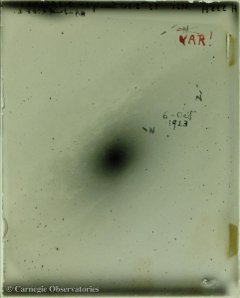Hubble's Glass Plate Negative of M31: In 1923, Hubble imaged M31, the Andromeda Galaxy (Messier 31), with the 100-inch Hooker telescope at Mt. Wilson Observatory. It is this image that led to his discovery of the first Cepheid variable star in M31. You can see where he wrote "VAR!" on the plate. He also made notes in ink labelling various novae.
Credit: Courtesy of the Carnegie Observatories
The 100-inch Hooker reflecting telescope at Mount Wilson was the most powerful telescope of the early 20th century. With this telescope, I was able to measure the distance to a Cepheid in the M31 nebula. It was over one million light years away! Using the method developed by Hertzsprung and later confirmed by Shapley himself, I was able to prove that there are objects in the sky outside of our own Galaxy and that these objects are themselves star systems.
It was determined that the star systems outside of our own Galaxy would be called external galaxies rather than nebulae. The collective optical light of the stars that make up the external galaxies allow them to be observable with telescopes and they are scattered through space as far as telescopes can see, sometimes in small clusters, but mostly uniformly across the sky.
The galaxies that appear large and bright are closer than those that appear small and faint. Astronomers have also noted by looking at the spectra that the light that reaches us from these observable galaxies is reddened. How much the light has shifted to the red end of the spectrum depends on how far the light has travelled through the Universe to reach us. Many astronomers think this velocity-distance phenomenon is evidence that the galaxies are moving away from the Milky Way and that the speed at which the galaxies are moving away from Earth increases the further away they are. The only two possible explanations are that our Galaxy is the center of the Universe, or that all galaxies are moving away from each other equally, meaning that the Universe itself is expanding!



